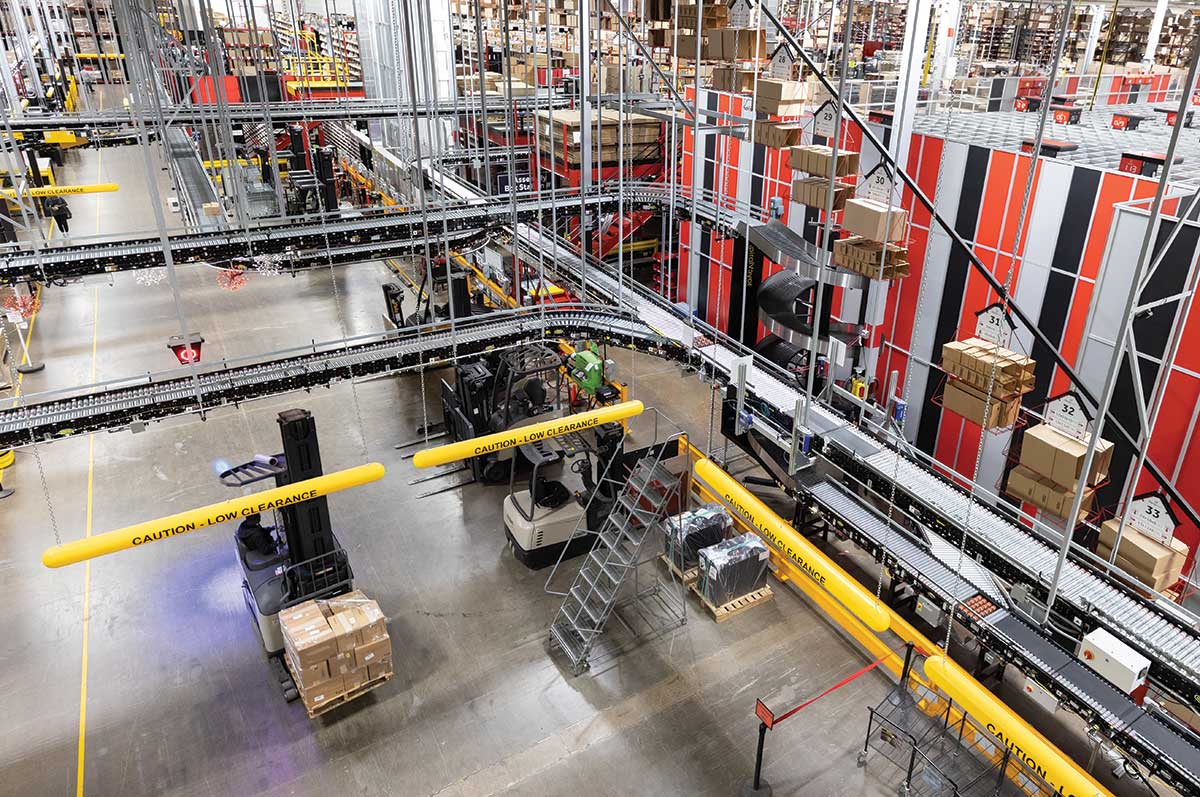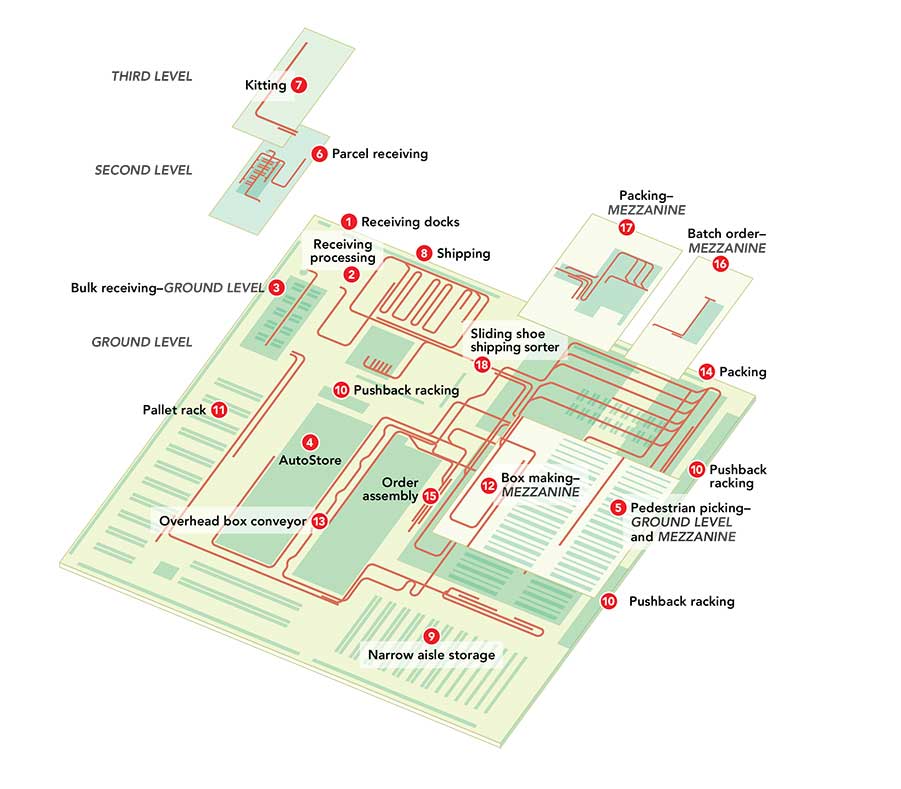Inside the Parts Town fulfillment center: Built for simplicity, speed and growth
Parts Town’s distribution center was designed from the ground up to speed parts out the door while laying the foundation for growth.

Addison, Ill.
Square Footage: 200,000 square feet plus 50,000 square feet of mezzanine space
Products Handled: Critical and spare OEM MRO parts
SKUS: 165,000 SKUs in stock, plus access to additional SKUs via partners
Throughput: 22,000 lines and 11,000 orders on a typical day
People/Shifts: Two 8-hour shifts per day/5 days per week plus one shift on Saturday
Parts Town’s distribution center was designed from the ground up to speed parts out the door while laying the foundation for growth. Our feature article goes in depth on the redesign.
Receiving
Incoming inventory is unloaded in receiving (1) and then sent to a three-level receiving and processing area (2). The ground level (3) processes palletized inventory. In this area, items are removed from packing, audited and then scanned into totes for storage in the AutoStore goods-to-person picking system (4) or in a pedestrian pick module or into narrow aisle storage for small parts storage (5).
The second level (6) processes parcel receipts. Once again, items are removed from their transport packaging and prepared for storage.
The third level (7) is referred to as a kitting area. There is also a ground level kitting area adjacent to receiving. There, eligible items are prepared for shipping in advance of an order so that they can be conveyed directly to shipping (8) if they are a single line order.
Putaway
There are several putaway processes, depending on the size of the storage methodology.
AutoStore
Totes with inventory eligible for the AutoStore are conveyed to an induction area where they are inspected, if necessary, audited and then scanned into corrugated cartons that are stored in AutoStore. There are three ports where product is inspected and eight induction ports.
Pedestrian pick module
Small parts are delivered to the pedestrian pick module for putaway.
Narrow aisle, pushback rack and pallet racking: Palletized items that can’t be handled by automation are stored in a VNA rack area (9), serviced by wire-guided vehicles for putaway and picking, in pushback racking (10) and in conventional pallet rack (11).
Box making
Shipping boxes are assembled on a mezzanine level work area (12). They are then placed in carriers on an overhead conveyor (13) that delivers boxes to the AutoStore pick tunnel. Much like a kanban system, the system is visual: The carriers are individually identified by number along with human readable information about the box sizes in each location on the carrier. Parts Town uses an algorithm to determine the optimal box sizes in the facility and for each order. The carriers continuously circulate at a relatively slow speed, which allows associates to easily remove required boxes, but also work around the overhead conveyor.
Picking
Parts Town aggregates its most frequently ordered parts in AutoStore. Associates are directed on the screen at their workstations as to what box size they need and then what items are to be picked to the box. Boxes are then placed on a takeaway conveyor. If no other items are required, the box is conveyed to packing (14).
Mutli-line orders
Multi-line orders picked from varying areas of the facility are delivered to an order assembly area on the ground floor (15). There, the first items for an order are scanned into a temporary storage location. Other items are then added to the order as they arrive. A complete order is then conveyed to packing.
Batch orders
Items that are picked in batch are conveyed to a batch order level (16) in the packing mezzanine. From there, they are sorted to the appropriate packing station.
Packing
Items that require documentation are conveyed to a packing mezzanine (17) where they are sorted to a pack station. There, orders are finalized, labeled and inducted onto the shipping sorter (18).
Shipping
To make the best use of space, the sliding shoe shipping sorter is located on a mezzanine level. Packages are sorted to a shipping lane based by carrier and delivery method.

System suppliers
- Systems Integration, Warehouse Exectution System: Bastian for the overall facility; BoxLogix for inbound conveyor, mezzanine structure and Chainveyor
- Goods-To-Person Picking: AutoStore
- Conveyors and Soration: Hytrol
- Inbound Conveyor: Chainveyor
- Spiral Conveyor: AmbaFlex and Ryson
- WMS: Korber Supply Chain
- Bar Code Scanning: Zebra Technologies
- Mobile Computers: Zebra Technologies
- Mezzanines: Wildeck
- Lift Trucks: Crown

Article Topics
Crown Equipment News & Resources
Lithium Transition: It’s all about the outcomes Jumping on the narrow aisle trend Your telematics data to-do listLatest in Logistics
FTR’s Trucking Conditions Index falls to lowest level since last September U.S. rail carload and intermodal volumes are mixed, for week ending May 11, reports AAR Cass Freight Index points to annual shipments and expenditures declines ALAN opens up its nominations for 2024 Humanitarian Logistics Awards U.S.-bound import growth remains intact in April, reports Descartes Looking at a reshoring history lesson NTSB: Ship lost power twice before slamming into Baltimore bridge, closing port More LogisticsAbout the Author
Subscribe to Logistics Management Magazine

Find out what the world's most innovative companies are doing to improve productivity in their plants and distribution centers.
Start your FREE subscription today.
May 2024 Logistics Management

Latest Resources














